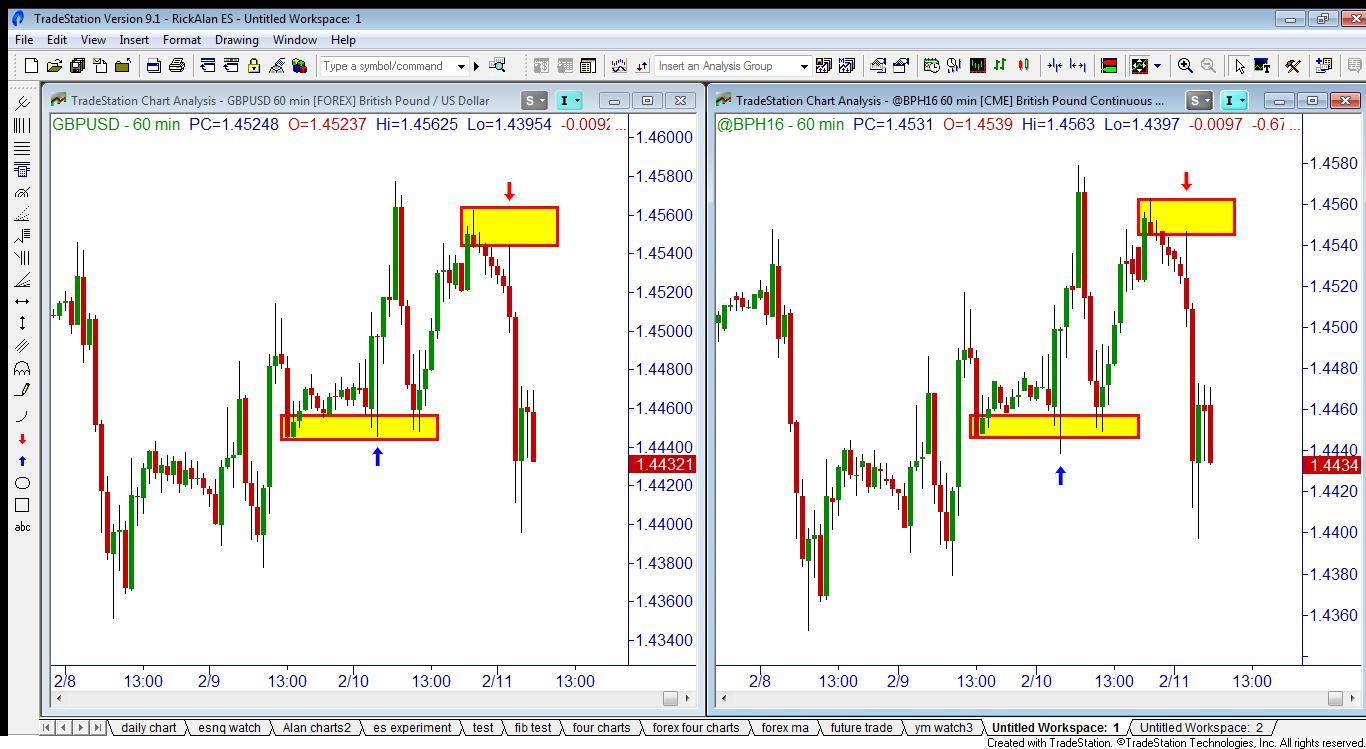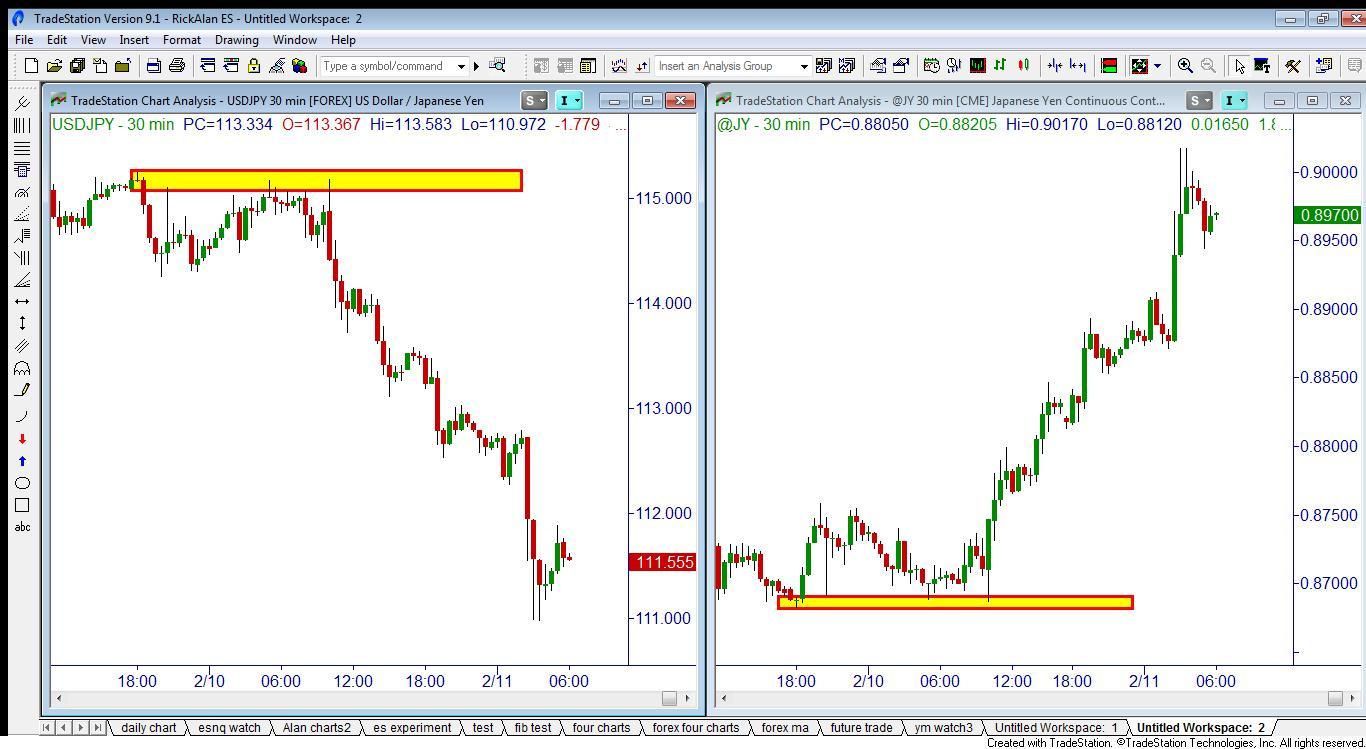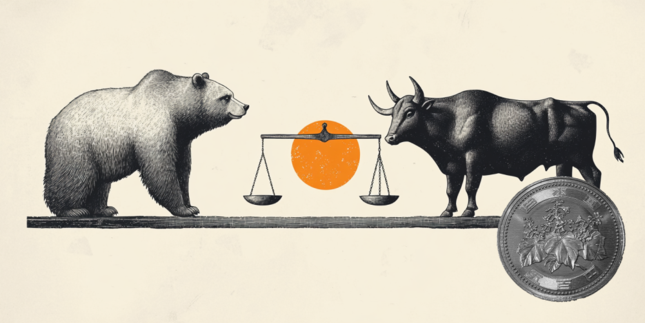
Hello traders! Before we get to this week’s official topic, I’d like to thank each and every one of you that voted for Sam Evans and myself for this year’s FXStreet Forex Best Awards 2016. Once again your votes allowed us to win in the “Best Educational Report” category for our Lessons from the Pros articles. Your votes are much appreciated, and winning again only motivates us more to do even better this year! Thanks again, now on with the official topic!
So last time we discussed the pros and cons of different asset classes. This week I’d like to expand a bit on the differences between trading currencies in the spot market vs. the futures market. Let’s look at a couple of charts first.

In this pair of charts I have the British Pound vs. the US Dollar in both the spot forex market on the left and in the futures market on the right. As you can see, the charts are nearly identical. The glaring difference I’d like to point out is where the two blue arrows are marked. On the spot chart, the GBPUSD did not break down below the marked demand zone, while the futures chart did. Both charts showed a retest of a supply zone which held on both charts, seen where the two red arrows are marked. So what does this mean? It is commonly said that the larger market is more important than the smaller one, and since the spot forex market trades more dollar value per day than the futures market more weight should be given to it. This does lead to a bit of a conundrum, however. With the decentralized market in the spot forex market (explained my last article) how can we “trust” that our broker is showing us the true market? Usually we don’t. I personally prefer to watch my broker’s charts and the corresponding futures market for confirmation. If they don’t line up, such as with the blue arrows, I don’t take the trade. When the markets do line up, check the red arrows again, I will take the trade. Simple as that.
Another thing to note is that these two charts are nearly identical because the British Pound is the base and the US Dollar is the quote. This is not always the case!

In this pair of charts, the USDJPY spot market is on the left while the Japanese Yen futures chart is on the right. Notice anything odd? They are nearly a perfect inverse to each other. This is because in the spot market the USD is the base while the Yen is the quote. When looking at the futures market, basically they are switched; the Yen is the base and the Dollar is the quote. Weird, isn’t it?
Noticing that the USDJPY had a small supply zone while at the same time the Yen futures chart was in demand could have led you to take a trade on either symbol because they both lined up. This is another type of confirmation for those of you who like that sort of thing.
Another small thing on the charts I’d like to point out is the prices. On the GBPUSD / BP chart, notice the slight difference in the actual prices quoted. Now look at the USDJPY / JY chart. Obviously with an inverse chart the prices will be wildly different, this is merely an easy math equation. I don’t really care what the prices are; I just want the charts to match as far as supply and demand. Keeping it simple is my preference!
Another interesting difference in spot forex vs. futures forex trading is the cost (or margin) that it takes to place an actual trade. When trading the GBPUSD, for example, your broker will probably require you to have 2% of the trade value in your account to place the trade. If you are planning on doing one standard lot, 100,000 value of the base currency, you would need about $2890 of US dollars in your account to place that trade. If you were to buy one contract of the BP your broker might charge you only $2035. So, futures can be cheaper to trade! Settle down though. With the GBPUSD, each pip will be worth $10. In the futures market, which trades in ticks instead of pips, the tick value for one contract of the BP is only $6.25. As you may know from your previous trading, not every pair has the same value per pip, which is the same in the futures market. So the big take away here is that different symbols will have different margin requirements, and they will also have different dollar values on the minimum moves (pips or ticks.)
The last difference we’ll discuss this week is an expansion of something briefly mentioned in the last article. Many traders will choose to open one account to trade one asset class, be it spot forex or futures. If you choose to open a forex account only, you will have access to many different currency pairs to choose from. These pairs range from the Major currency pairs including the EURUSD, AUDUSD, USDCAD, all the way to some of the more obscure pairs like the EURPLN (EURO vs the Polish Zloty). While these obscure pairs might look good to you on a spot forex chart, trying to trade them in a futures account might be a problem. The main reason is the lack of volume, or even possibly the lack of the pair even trading in the futures market! If you choose to open a futures account, you will have access to the major currency pairs, in addition to other contracts like wheat, gold, oil, etc. But access to all of the currency pairs will be limited.
So there you have it traders! A few expanded differences on spot forex vs. futures forex trading. Personally, I trade both asset classes as I like the benefits that they both have to offer! As always, please do your own research on your chosen broker to determine what is right for you and your circumstances; even ask your Online Trading Academy Education Counselor for their recommendation.
This content is intended to provide educational information only. This information should not be construed as individual or customized legal, tax, financial or investment services. As each individual's situation is unique, a qualified professional should be consulted before making legal, tax, financial and investment decisions. The educational information provided in this article does not comprise any course or a part of any course that may be used as an educational credit for any certification purpose and will not prepare any User to be accredited for any licenses in any industry and will not prepare any User to get a job. Reproduced by permission from OTAcademy.com click here for Terms of Use: https://www.otacademy.com/about/terms
Editors’ Picks

EUR/USD accelerates losses to 1.0930 on stronger Dollar
The US Dollar's recovery regains extra impulse sending the US Dollar Index to fresh highs and relegating EUR/USD to navigate the area of daily troughs around 1.0930 in the latter part of Friday's session.

GBP/USD plummets to four-week lows near 1.2850
The US Dollar's rebound keep gathering steam and now sends GBP/USD to the area of multi-week lows in the 1.2850 region amid the broad-based pullback in the risk-associated universe.

Gold trades on the back foot, flirts with $3,000
Gold prices are accelerating their daily decline, steadily approaching the critical $3,000 per troy ounce mark as the Greenback's rebound gains extra momentum and US yields tighten their retracement.

Can Maker break $1,450 hurdle as whales launch buying spree?
Maker holds steadily above $1,250 support as a whale scoops $1.21 million worth of MKR. Addresses with a 100k to 1 million MKR balance now account for 24.27% of Maker’s total supply. Maker battles a bear flag pattern as bulls gather for an epic weekend move.

Strategic implications of “Liberation Day”
Liberation Day in the United States came with extremely protectionist and inward-looking tariff policy aimed at just about all U.S. trading partners. In this report, we outline some of the more strategic implications of Liberation Day and developments we will be paying close attention to going forward.
RECOMMENDED LESSONS
Making money in forex is easy if you know how the bankers trade!
Discover how to make money in forex is easy if you know how the bankers trade!
5 Forex News Events You Need To Know
In the fast moving world of currency markets, it is extremely important for new traders to know the list of important forex news...
Top 10 Chart Patterns Every Trader Should Know
Chart patterns are one of the most effective trading tools for a trader. They are pure price-action, and form on the basis of underlying buying and...
7 Ways to Avoid Forex Scams
The forex industry is recently seeing more and more scams. Here are 7 ways to avoid losing your money in such scams: Forex scams are becoming frequent. Michael Greenberg reports on luxurious expenses, including a submarine bought from the money taken from forex traders. Here’s another report of a forex fraud. So, how can we avoid falling in such forex scams?
What Are the 10 Fatal Mistakes Traders Make
Trading is exciting. Trading is hard. Trading is extremely hard. Some say that it takes more than 10,000 hours to master. Others believe that trading is the way to quick riches. They might be both wrong. What is important to know that no matter how experienced you are, mistakes will be part of the trading process.

The Best brokers to trade EUR/USD
SPONSORED Discover the top brokers for trading EUR/USD in 2025. Our list features brokers with competitive spreads, fast execution, and powerful platforms. Whether you're a beginner or an expert, find the right partner to navigate the dynamic Forex market.
